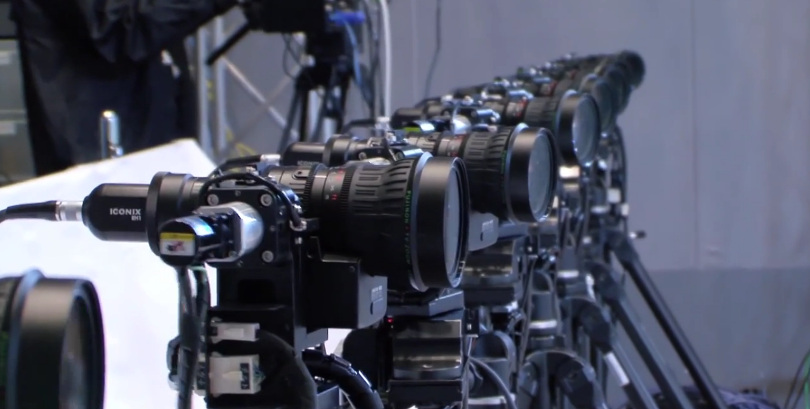Special effects in “Matrix” style for sports TV broadcasts

The idea of using the flyby effect of a slow-motion camera of an almost motionless object ( bullet time ), which has become popular due to the film The Matrix, is not new for shooting sports events. Back in 2001, the EyeVision system of thirty cameras was used during the broadcast of the American Football Super Cup. However, then the technology did not allow it to be done quite smoothly and beautifully. The computer was used primarily for coordinated camera control, and a very fast switching of the signal coming from the thirty separate video recorders associated with each camera was used to create the overwhelm effect.
In the cinema, the effect was achieved due to fully controlled shooting conditions and long post-processing. To do the same in real time, without duplicates and pre-directed movements of actors is much more difficult. But today, finally, there are systems capable of it. Perhaps soon they will become the same familiar component of sports broadcasts as slow repetition.
The Japanese television and radio company NHK is testing a robotic multi - camera system of nine video cameras . The master camera is controlled by the operator, the rest by the computer The direction, focal length and zoom of the slave cameras are calculated by the computer in real time, so that the frames from them can be glued together in a sequence that simulates a camera fly-around of a fixed subject.
')
Slave cameras do not just repeat all the movements of the leader - the angle of rotation and the focus of each of them are slightly different, so that they all look strictly at one point. Video from the cameras is also processed in the computer to make the effect smooth and neat. This is reminiscent of the original cinematic technology, when morphing was used for a smooth transition between frames from different cameras. So far, the calculation of one sequence takes about a minute. In the future, this can be done in almost real time, and the number of cameras can be much more than nine.
The Israeli company Replay Technologies , which recently introduced FreeD technology, has advanced even further. Unlike the classical scheme with a very large number of cameras and predominantly two-dimensional post-processing algorithms, such as morphing or interpolation, the FreeD system relies almost entirely on three-dimensional modeling. Based on images from several cameras, a photo-realistic 3D model of the frame to be flown is built. The whole process takes about 30 seconds. In fact, instead of the original image, although subjected to post-processing, there is a short computer animation broadcast that is visually indistinguishable from a real video.
In June of this year, FreeD has already worked on several baseball games at Yankees Stadium in New York, and on September 8, NBC will use it during an American football match at Cowboys Stadium in Dallas. Technologies of the same company were used during the 2012 Olympics in London during gymnastics competitions.
Instant replays in the bullet time style are also interesting because they allow to improve the quality of refereeing - now it is possible to view a controversial moment not only in slow time, but also from a very large number of foreshortenings. And the use of 3D modeling reveals wide opportunities for sports analytics - if we have a dynamic digital model of the game moment, it is quite easy to get almost any data about the speed and strength of strikes, jump height and body position of athletes without using special sensors.
Source: https://habr.com/ru/post/189470/
All Articles